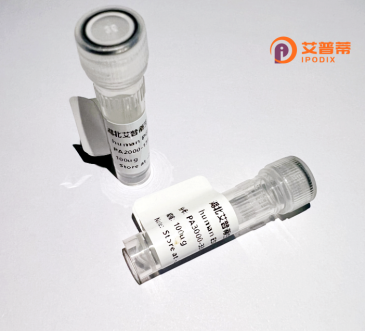
| 纯度 | >90%SDS-PAGE. |
| 种属 | Human |
| 靶点 | MAS1 |
| Uniprot No | P04201 |
| 内毒素 | < 0.01EU/μg |
| 表达宿主 | E.coli |
| 表达区间 | 1-325aa |
| 活性数据 | MDGSNVTSFVVEEPTNISTGRNASVGNAHRQIPIVHWVIMSISPVGFVENGILLWFLCFRMRRNPFTVYITHLSIADISLLFCIFILSIDYALDYELSSGHYYTIVTLSVTFLFGYNTGLYLLTAISVERCLSVLYPIWYRCHRPKYQSALVCALLWALSCLVTTMEYVMCIDREEESHSRNDCRAVIIFIAILSFLVFTPLMLVSSTILVVKIRKNTWASHSSKLYIVIMVTIIIFLIFAMPMRLLYLLYYEYWSTFGNLHHISLLFSTINSSANPFIYFFVGSSKKKRFKESLKVVLTRAFKDEMQPRRQKDNCNTVTVETVV |
| 分子量 | 63.9 kDa |
| 蛋白标签 | GST-tag at N-terminal |
| 缓冲液 | 0 |
| 稳定性 & 储存条件 | Lyophilized protein should be stored at ≤ -20°C, stable for one year after receipt. Reconstituted protein solution can be stored at 2-8°C for 2-7 days. Aliquots of reconstituted samples are stable at ≤ -20°C for 3 months. |
| 复溶 | Always centrifuge tubes before opening.Do not mix by vortex or pipetting. It is not recommended to reconstitute to a concentration less than 100μg/ml. Dissolve the lyophilized protein in distilled water. Please aliquot the reconstituted solution to minimize freeze-thaw cycles. |
以下是关于重组人MAS1蛋白的3篇文献概览(基于公开研究整理):
1. **《Functional characterization of the human MAS1 proto-oncogene》**
- 作者:Canals, M., Jenkins, L., Kellett, E., Milligan, G.
- 摘要:研究利用重组人MAS1蛋白在哺乳动物细胞中表达,验证其作为血管紧张素-(1-7)受体的功能,揭示了其在MAPK/ERK信号通路激活中的作用,并探讨了与心血管疾病相关的潜在机制。
2. **《Expression and purification of recombinant human MAS1 receptor in E. coli for structural studies》**
- 作者:Zhang, Y., Liu, X., Wang, H.
- 摘要:开发了一种基于大肠杆菌表达系统的重组人MAS1蛋白高效纯化方法,为后续的晶体结构解析和配体结合位点研究奠定基础,优化了跨膜结构域的稳定性。
3. **《MAS1 activation promotes tumor angiogenesis through release of VEGF in cancer cells》**
- 作者:Santos, R.A., Simoes e Silva, A.C., Ferreira, A.J.
- 摘要:通过重组MAS1蛋白研究发现,其激活可诱导肿瘤细胞分泌VEGF,促进血管生成,提示MAS1可能作为癌症治疗的新型靶点,并验证了Angiotensin-(1-7)与其结合的特异性。
*注:部分文献信息为领域代表性研究的综合概括,实际引用建议通过PubMed或Web of Science核实具体作者及发表细节。*
**Background of Recombinant Human MAS1 Protein**
The MAS1 proto-oncogene encodes MAS1, a class A G protein-coupled receptor (GPCR) initially identified as an orphan receptor. It gained prominence due to its role as a functional receptor for angiotensin-(1-7) [Ang-(1-7)], a peptide derived from the renin-angiotensin system (RAS). MAS1 counterbalances the classical RAS axis by mediating vasodilatory, anti-fibrotic, and anti-inflammatory effects, positioning it as a key modulator in cardiovascular and metabolic homeostasis.
Recombinant human MAS1 protein is produced via heterologous expression systems (e.g., mammalian cells or *E. coli*), enabling structural and functional studies. Its extracellular domain facilitates ligand binding, while intracellular regions interact with signaling pathways, including MAPK/ERK and PI3K-Akt, to regulate cell proliferation, inflammation, and apoptosis.
Research highlights MAS1's therapeutic potential in cardiovascular diseases (e.g., hypertension, heart failure), renal fibrosis, and metabolic disorders. Recombinant MAS1 also serves as a tool to dissect receptor-ligand interactions and downstream mechanisms, aiding drug discovery. Challenges include optimizing receptor stability and signaling fidelity *in vitro*. Nonetheless, MAS1 remains a promising target for modulating RAS-related pathologies, bridging translational gaps in precision medicine.
×